.jpg) |
| Click for the Flickr set. |
Friday, November 1, 2013
The "C21 Pentagram" Photo Filter
Friday, October 18, 2013
Telemetry Before It Happens
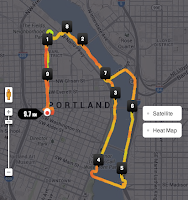 I'd like to borrow another runner's memory.
I'd like to borrow another runner's memory.I've been traveling a lot, and it's easy to scope out a route near each hotel using Google Maps' measurement tool and some Street View sleuthing. But knowing when a turn is coming up, or the sidewalk becomes choppy dirt, or the hill evens out just past the firehouse .. you don't know those on the first run.
My Nike GPS watch gives me telemetry after each run. What I need is telemetry before. Start out the route on my second run, and I'm a little better prepared for the details.
But is the novelty of the first-time around "worth" something?
Nope. What if the borrowed runner is used to marathons .. I'll bet she'll have a different stride and pace than me. Or what if this is a noontime stroll I'm borrowing .. maybe he's never seen it in the evening with the city lights glimmering. "Interesting, I've never done it this slow/late/sober/male/lean ..."
So, GPS running-accoutrement makers, how about it? Telemetry after my run is so 5k ago. I'll pay extra to have it up-front.
Labels:
futures,
quantified self,
running
Location:
Joaquin Miller House, Oakland, CA, USA
Monday, September 23, 2013
Toggle a MacBook's Wifi with a Bash One-Liner
Sometimes the easiest way is a bash one-liner. (Think Alfred shortcuts, BetterTouchTool gestures, Terminal.app.) Running an applescript is all fine and dandy, but it's heavy. Here's how to toggle your MacBook wifi on or off, where the wifi interface is en0.
This is one of those messed-up bash-isms that uses conditional logic in the "wrong" way, elegantly.
( networksetup -getairportpower en0 | grep On ) \ && ( networksetup -setairportpower en0 Off ) \ || ( networksetup -setairportpower en0 On )
This is one of those messed-up bash-isms that uses conditional logic in the "wrong" way, elegantly.
Tuesday, September 17, 2013
Setting Processing's User-Agent for loadXML
In Processing, I'm fetching Yahoo's weather forecast for my location. The loadXML() function is perfectly happy to take a URL, so I can just point it at my location's RSS feed.
In its default mode, this sends a user-agent string of "Java/1.6.0_51" which reflects my current Java version. But I want to set my User-Agent, to something more descriptive. If my project misbehaves, or an operator gets curious, it would be polite to have a more descriptive string with some contact info.
You can prepend a string to the user-agent by specifying it in your setup() function.
void setup () {
System.setProperty("http.agent", "abstractForecast; https://github.com/fnaard/abstractForecast;");
}
In its default mode, this sends a user-agent string of "Java/1.6.0_51" which reflects my current Java version. But I want to set my User-Agent, to something more descriptive. If my project misbehaves, or an operator gets curious, it would be polite to have a more descriptive string with some contact info.
You can prepend a string to the user-agent by specifying it in your setup() function.
void setup () {
System.setProperty("http.agent", "abstractForecast; https://github.com/fnaard/abstractForecast;");
}
Which results in the web server logging a user-agent of:
abstractForecast; https://github.com/fnaard/abstractForecast; Java/1.6.0_51
Oracle has some documentation on the network properties you can set. There are more, notably: proxy settings, IPv4/v6 preference, and DNS caching behavior.
Labels:
data visualization,
processing
Location:
Hillcrest, San Diego, CA, USA
Sunday, September 1, 2013
Types of PS3 Hard Drive Caddies
I sent a friend's PS3 in for service, and they ask you to pull out your hard drive if you've upgraded it. I did, but then at some point I discarded or lost the caddy that it belongs in. There are four generations of PS3, and each has its own style of caddy. Here's how it goes.
Generation
|
Models
|
Caddy
|
Old Fatty
|
CECHA01
CECHB01
CECHG01
CECHE01
|
Wire Pull-Tab
|
Newer Fatty
|
CECHH01
CECHK01
CECHL01
CECHP01
|
Flat Metal Pull-Tab
|
Slim
|
CECH-2001A
CECH-2001B
CECH-2101A
CECH-2101B
CECH-2501A
CECH-2501B
CECH-3001A
CECH-3001B
|
Side Flange
|
Slimmer
|
CECH-4001B
CECH-4001C
|
Swing-Out Tab
|
Friday, July 5, 2013
Loading 35 mm Film into a 126 Cartridge
A friend picked up a Kodak Instamatic 404 for me, a while ago. It uses 126 film cartridges, which are 35 mm (-ish) film inside a sealed, easy-to-load cartridge. Off I went to eBay, and found a used roll for ten dollars including shipping.
Pulling the cartridge apart is the hardest bit. I found a great post on how to do it. You'll need to twist, tease, and pry it apart. The two halves of my Kodacolor II cartridge were glued/fused at four points inside, two on each side. Pictured at right, the arrows are pointing to those spots, which may help you do it yourself.
With the cartridge eviscerated, I taped the start of some 35 mm film to the take-up spool and got to work in the changing bag. I pulled out an arm's length of film, cut it, and rolled it up loose. I wrangled the take-up spool into the big side, and held the loose roll in the small side, then snapped the cartridge back together.
I'm assuming the Instamatic is reasonably light-tight once it's closed. So rather than try to tape-up the edges of the cartridge -- so I could load a camera in daylight -- I just added the camera to my changing bag, dropped in the cartridge, and closed the camera's door.
As detailed in a fantastically technical post, there are some interesting differences between the teeth on 35 mm film and the "notches" on actual 126 film. In short, the camera will think it has advanced a whole frame, before it's actually done it. So, for each picture I took, I advanced the film, then held my hand over the lens and took a blank shot, so I could advance a second time.
The resulting photos are pretty gnarly. For one thing, I was using 400 speed film in a 100 speed camera. For another, the tape I put over the frame-count window on the cartridge was obviously not opaque enough. Armed with these data, I think the next roll is going to be better.
 |
| Fused spots. Click for full size. |
With the cartridge eviscerated, I taped the start of some 35 mm film to the take-up spool and got to work in the changing bag. I pulled out an arm's length of film, cut it, and rolled it up loose. I wrangled the take-up spool into the big side, and held the loose roll in the small side, then snapped the cartridge back together.
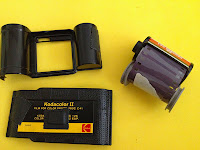 |
| Ready for the changing bag! |
As detailed in a fantastically technical post, there are some interesting differences between the teeth on 35 mm film and the "notches" on actual 126 film. In short, the camera will think it has advanced a whole frame, before it's actually done it. So, for each picture I took, I advanced the film, then held my hand over the lens and took a blank shot, so I could advance a second time.
The resulting photos are pretty gnarly. For one thing, I was using 400 speed film in a 100 speed camera. For another, the tape I put over the frame-count window on the cartridge was obviously not opaque enough. Armed with these data, I think the next roll is going to be better.
Labels:
film,
kodak instamatic 404
Location:
Hillcrest, San Diego, CA, USA
Monday, June 17, 2013
Crib Notes for Cocktail Hour
Fill those awkward I'm-just-not-terribly-interesting pauses in conversation with these things.
Now you're interesting.
- A breathing dress .. fascinating and spooky. Imagine the sorts of sensors you might add to it. Pulse, proximity, noise, EEG ..
- And another robotic dress, with freaky insect-like epaulettes. If we're willing to attach smart-phones, pedometers, prosthetic limbs, corrective lenses .. why not an autonomous exoskeleton?
- Rogaine for the Inner Ear? Research suggests that altered gene expression can restore hearing loss (some), by regrowing hairs in the inner ear. Crank it up to eleven.
- It occurred to me on a recent flight, that with everyone on e-readers, your neighbors can't see the cover of your book. A paper book broadcasts its title to others folks -- perhaps inviting conversation, but certainly indicating your interests -- while the e-reader just shows its own branding. Should we make digital dust jackets, so friends can see the smarty-pants books we're e-reading?
Now you're interesting.
Labels:
cocktail hour
Location:
Sorrento Valley, San Diego, CA, USA
Saturday, June 15, 2013
First Roll on the Agfa Isoflash Rapid
I picked up an odd little Agfa camera, the Isoflash Rapid, a while ago. It uses two canisters that hold 35 mm film, but that lack winding spools. The advancing teeth pull film out of one cartridge and sort of "shove" it into the receiving side. There's a fantastic write-up at lomography that goes into all the details of Agfa's Rapid brand.
I only have the "take up" canister, and a 35mm canister is slightly too tall to just remove the spool part and drop in. What I did was get the camera and a roll of Ilford XP2 Super into a changing bag and improvise. I pulled out some XP2 and cut it off. I stuck a half-inch or so into the take-up canister. Then I just rolled up the rest of the film and put it, un-canistered, on the other side. I shut the camera, and hoped it would feed the loose film into the canister properly.
Mechanically, it ended up working just fine. After I'd shot the roll, I threw the camera into my changing bag and rolled the film into an empty 35mm canister for its trip to the lab. Naturally, the camera wasn't built for 400 speed film, so the film got totally cooked. But the camera does function, and my film kludge did work. The results are in a Flickr set.
I only have the "take up" canister, and a 35mm canister is slightly too tall to just remove the spool part and drop in. What I did was get the camera and a roll of Ilford XP2 Super into a changing bag and improvise. I pulled out some XP2 and cut it off. I stuck a half-inch or so into the take-up canister. Then I just rolled up the rest of the film and put it, un-canistered, on the other side. I shut the camera, and hoped it would feed the loose film into the canister properly.
 |
| Click for the Flickr Set |
Location:
Hillcrest, San Diego, CA, USA
Sunday, June 2, 2013
Summer Quarter Choices
My iOS class has only a couple of sessions left. I looked over the Extension course catalog this week. Here's the short-list of classes I'm trying to choose from.
It will likely come down to a nerdy shoot-out of data mining, three-d modeling, and embedded systems. Nutrition science would be a sensible choice though -- and fascinates me -- so it keeps being on the list. This should be an interesting quarter!
- Data Mining I: Basic Methods and Techniques
- 3DS Max I
- Story Telling for an Interview or Negotiation
- Introduction to Embedded Systems
- Introduction to Photography in the Digital Age
- (slog. but pre-requisite for pretty much everything else in the department.)
- Introduction to Nutrition Science
It will likely come down to a nerdy shoot-out of data mining, three-d modeling, and embedded systems. Nutrition science would be a sensible choice though -- and fascinates me -- so it keeps being on the list. This should be an interesting quarter!
Thursday, May 23, 2013
Total Control Advanced Riding Clinic
A couple weekends ago, I attended Lee Parks' Total Control Advanced Riding Clinic. It was held on a helicopter landing zone (LZ 16) at Camp Pendleton. It's a nice large swath of level concrete. Classroom portions of the day were held in an adjacent explosives training building. This venue just has "danger" written all over it .. figuratively and literally.
The course is intended for street riding (most other courses are about the track) and I gained a whole lot more confidence in my bike and myself. We learned to smooth out acceleration and deceleration, to keep the bike level, to flop into turns. We even learned how our suspension works, and how to adjust it to match the rider's weight.
On the course, the class was broken into teams of five or six, with a section of the zone to themselves. Each group had an instructor dedicated, and instructors were rotated among teams with each new exercise. The personal attention really made a difference.
A really interesting moment came when we were preparing for lean-off turns. In the classroom, we ran through the steps of a lean-off turn. But on the course, rather than just wing it, we practiced it on our bikes while standing still. Each group surrounded a single rider's bike. The rider got on, and then actually got to try the technique, with the group leaning the bike to simulate it.
It's just about the only time I got out my phone during the whole eleven hour span, just to shoot this video. Incidentally, when they showed the whole class how we'd be doing this, they demonstrated on me. Talk about pressure to get it right..
The course is intended for street riding (most other courses are about the track) and I gained a whole lot more confidence in my bike and myself. We learned to smooth out acceleration and deceleration, to keep the bike level, to flop into turns. We even learned how our suspension works, and how to adjust it to match the rider's weight.
On the course, the class was broken into teams of five or six, with a section of the zone to themselves. Each group had an instructor dedicated, and instructors were rotated among teams with each new exercise. The personal attention really made a difference.
It's just about the only time I got out my phone during the whole eleven hour span, just to shoot this video. Incidentally, when they showed the whole class how we'd be doing this, they demonstrated on me. Talk about pressure to get it right..
Labels:
bike
Tuesday, March 19, 2013
Pervasive UI Silliness
- ATMs ask how many dollars and cents you want to withdraw. Have they ever been able to dispense cents?
- Online stores ask for your card type .. but the numbers' format already tells them the card type. For instance, sixteen digits starting with a four are always Visa.
- And some carts ask your card's expiration date, but populate the month menu with names rather than numbers. Does anyone have a card that actually spells out the month's name?
Labels:
user interface
Location:
Sorrento Valley, San Diego, CA, USA
Kodak No.1-A Pocket
Say hello to the Kodak No.1-A Pocket camera. The "A" in the model is for autographic, just like the Vest Pocket cameras have. This wasn't a swap meet special -- I actually paid a few bucks. Not enough to think it works at all, though.
In contrast to the point-and-shoot Kodaks like the Brownies, this one offers f-stops from 6.3 to 45. It's got 1/25 and 1/50 shutter speeds, as well as a manual shutter. Additionally, like the Vest Pocket cameras, it has a "timed" setting, where you click the shutter once to open, then click a second time to close it.
It takes 116-size film. Luckily, it had a take-up spool in it. I threw in a roll of 120-size Fujifilm Pro 400H, which is noticeably narrower than the 116, so it sat loose in there. I had to guess on how far to roll the film to advance it one "frame." I turned the advance knob eight 360° rotations between photos. I got at least two shots on this roll. If the thing isn't a complete light-leak-special, I'll be able to back-out how many rotations I actually need to advance a single frame of 120 film.
I might take a shot at 3d-printing a 116-size adapter that's specifically designed to kludge a 120-size film roll securely into place. I've been meaning to try printing spools ever since chopping 120 spools down to 620.
In contrast to the point-and-shoot Kodaks like the Brownies, this one offers f-stops from 6.3 to 45. It's got 1/25 and 1/50 shutter speeds, as well as a manual shutter. Additionally, like the Vest Pocket cameras, it has a "timed" setting, where you click the shutter once to open, then click a second time to close it.
 |
| left: 116 right: 120 |
I might take a shot at 3d-printing a 116-size adapter that's specifically designed to kludge a 120-size film roll securely into place. I've been meaning to try printing spools ever since chopping 120 spools down to 620.
Labels:
kodak pocket
Location:
Sorrento Valley, San Diego, CA, USA
Fewer Clocks
 A couple months ago, I moved my weather/clock Sony Dash from being centrally located -- easily visible -- to a more remote corner of my livingroom space. The workday is filled with glances at the clock, mental checks of the calendar, and quick calculations of time remaining to get today's critical tasks done. The livingroom doesn't really need to do that. (At least not as much.)
A couple months ago, I moved my weather/clock Sony Dash from being centrally located -- easily visible -- to a more remote corner of my livingroom space. The workday is filled with glances at the clock, mental checks of the calendar, and quick calculations of time remaining to get today's critical tasks done. The livingroom doesn't really need to do that. (At least not as much.)So a few weeks ago, I switched my bike's console from showing the time to showing its total mileage. After all, what's the use of knowing minute-to-minute how early/late I'm going to be? It's a bad idea to be in a hurry on two wheels.
I'm enjoying the change.
It makes me wonder if there's a philosophical/hypertension difference between people with wrist-watches and anachronists who use their smartphone as a pocket-watch. There's got to be an entire history of cultures' concepts of time, and the ways they sync their collective knowledge of the current time. Does a citywide clock tower's chimes count as hive-mind infrastructure?
Labels:
quantified self
Location:
Sorrento Valley, San Diego, CA, USA
Tuesday, February 26, 2013
Whitehouse Beacon II
 This is the Whitehouse Beacon II. I'd never even heard of the Whitehouse company, but it was President's Day, so I had to get it. Manufacturing spanned 1947 to 1955 -- that's Truman and a little Eisenhower.
This is the Whitehouse Beacon II. I'd never even heard of the Whitehouse company, but it was President's Day, so I had to get it. Manufacturing spanned 1947 to 1955 -- that's Truman and a little Eisenhower.
It's got a fixed aperture of f/11, and the shutter is something like 1/50 of a second. This is the early model, which includes a manual shutter option that was absent on the later versions. (I blame Ike.) I took it to Drink & Draw to shoot a roll of Rollei Crossbird slide film on it. At ISO 200, the shutter times were around two seconds. We'll see what happens!
Labels:
film,
whitehouse beacon ii
Location:
Sorrento Valley, San Diego, CA, USA
Sunday, February 24, 2013
Kodak Baby Brownie
I picked up this little Kodak Baby Brownie last week. It came in a pair, with a Baby Brownie Special. I'm trying the "non-Special" first.
The great copypaste feedback loop that is the Internet suggests it's got a fixed aperture of f/11. And the shutter speed is "around" one fortieth of a second. This is the domestic model, sold between 1934 and 1941. An export model was created later, which offered a manual shutter mode. (Sold in the UK between 1948 and 52.)
It takes 127 format film, and I've just shot a roll of efke 100 on it in bright sunlight. My light meter -- given f/11 on 100 speed film -- varied between recommending 1/125 and 1/8 shutter speeds as I tried a few different lighting conditions. We'll see what comes out!
Labels:
film,
kodak baby brownie
Location:
Hillcrest, San Diego, CA, USA
Saturday, February 16, 2013
Spring Quarter Choices
So in the current winter quarter, I'm taking a drawing class. It's fantastic. Now, I tend to ping-pong between tech and humanities, so tech "should" be next. The only criteria are that it needs to be in the evening, and needs to be in an actual classroom so that I can block it out as a "meeting" in my calendar. Here's the schizoid short-list:
- iOS Programming I (pig latlong app?)
- Chinese Communication I (trendy, but I'm curious.)
- Nature Photography (viewmaster mark ii hits the road.)
- How to Start a New Business (same thing we do every night, pinkie..)
Weird options, I know. Flip a coin until I'm happy with the outcome, I suppose.
Wednesday, February 6, 2013
Crib Notes for Cocktail Hour
Here's what I'll be chatting about, while enjoying a tasty beer with interesting people.
- If you haven't already heard of the Facebook app, Bang With Friends, you're going to soon. Tell it which of your friends you'd like to have benefits with, and if they pick you too, it lets you know.
- Will an app like that reverse the trend suggested by a recent Pew Internet study suggesting that Facebook users are scaling back their use? Or will it keep them too busy offline, to check in?
- And there's always time for some high-tech eye-candy. I've been drooling about Audi's new concept for OLED indicator lights. I've got to make some of these for my motorcycle!
Labels:
cocktail hour
Location:
Hillcrest, San Diego, CA, USA
Sunday, February 3, 2013
Glove Parts
My friend Erica challenged me on my birthday. She sent me three Lilypad pieces -- an RGB LED, an accelerometer, and an electret microphone. The "challenge" part is that she packed them inside a CD jewel case .. with my face photoshopped onto Imogen Heap showing off her gloves.
I've already got an old mainboard, and a bunch of conductive thread. I picked up a cheap pair of fabric gloves while I was running an errand on Friday. I'm going to sew this stuff together and see what it might like to be when it grows up.
I've already got an old mainboard, and a bunch of conductive thread. I picked up a cheap pair of fabric gloves while I was running an errand on Friday. I'm going to sew this stuff together and see what it might like to be when it grows up.
Saturday, January 26, 2013
PS3.14 Enclosure for Raspberry Pi
Tin, this is Dremel. Dremel, meet Tin. Pi, I'd like to introduce you to Tin and Dremel.
A couple hours later, I've got an enclosure for my Pi that looks really cool sitting next to my full-size PS3. I'm calling it the PS3.14.
do-it-yourself --terse
- Remove felt card-holder insert and plastic ring that makes the lid stay on.
- Drop in Raspberry Pi and measure where the cables will come out.
- Put on eye protection. (Seriously, do not cut metal without eye protection.)
- Cut slots into the tin to accomodate cables.
- Slice a horizontal slot where the SD card will come out.
- Line the bottom tin with electricians' tape to avoid shorting.
- Pop in the Pi and cable it up.
- Put the top tin back on and tape it to the bottom tin, at the back, for a hinge.
- Tidy up your cables and stick the little guy on the shelf next to your real PS3.
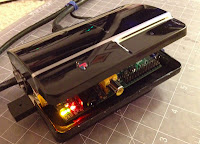
do-it-yourself --verbose
Find a workspace that you're not going to mind having metal shards and enamel dust all over. I'd say lay down some newspaper, but you don't want to get all that junk on your iPad.
 Removing the felt piece and the plastic ring are super simple, since nothing's glued down. Pop them out. The felt you can toss, or keep, or sell on ebay. The ring you may want to save for later, if you're ambitious, but you probably don't need it.
Removing the felt piece and the plastic ring are super simple, since nothing's glued down. Pop them out. The felt you can toss, or keep, or sell on ebay. The ring you may want to save for later, if you're ambitious, but you probably don't need it.Drop in the Pi, and mark where to cut slots for the cables. This is not an exact science, since the Pi is a little smaller than the tin. Just hold it steady in one spot, while you mark all the slot locations. I plugged in my cables to double-check the slot widths .. my HDMI cable, for instance, is wider than the plug, so I needed a wider slot there.
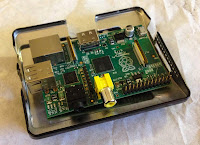
Put on eye protection. Do not skip this step. I know, I sound like your high school shop teacher who insisted you put on goggles even when you were just making that stupid wooden elephant-shaped lamp that never worked anyway. A rotary tool is going to be kicking off metal bits and you do not want those in your eyes. A hack/jig/jeweler's saw is probably not so dangerous, and might be a good alternative, but I didn't try that.
To cut out the cable slots, I used a Dremel Stylus equipped with an EZLock Thin Cut 1 1/2" cutting disk. I varied the rotation speed between 4 and 6, to minimize the sparking and generally keep a little better control over things. Some sparks will fly off, but if you start to go all Jennifer Beals on the thing, slow down and/or use a lower RPM.
 Cutting the SD card slot is sneaky, but simple enough. Hold your SD card against the side of the tin, where it's going to protrude, and mark the width of the slot you're going to cut. Your first cut will be wide enough for the SD card, but not tall enough. Cut another slice right next to that, and repeat until it's large enough. As a guide, the rows of dots dimpled into the side of the tin are about the same thickness as an SD card, so you can just hack out a row of those.
Cutting the SD card slot is sneaky, but simple enough. Hold your SD card against the side of the tin, where it's going to protrude, and mark the width of the slot you're going to cut. Your first cut will be wide enough for the SD card, but not tall enough. Cut another slice right next to that, and repeat until it's large enough. As a guide, the rows of dots dimpled into the side of the tin are about the same thickness as an SD card, so you can just hack out a row of those.Lining the tin with electricians' tape is intended to keep the exposed circuits on the bottom of the card from shorting against the metal of the tin. Since this is all on the inside, you can be pretty informal about it. I laid long overlapping strips into mine, then cut off the excess around the top lip of the tin and around the borders of the cable slots.
 Attach the lid with a tape "hinge" on the back. A tape hinge at the back will keep the tin halves lined up nicely, while leaving the Pi easily accessible. Initially I tried to glue pieces of the plastic lid-holding ring back into the bottom tin. This was a spectacular failure. On reflection, I'm not sure it would even work the way I wanted, since the plastic part needs to bend a little when the lid is snugly closed. (Extra credit: use curled bits of jumper wire glued somehow to protrude above the lip height, to grab the top tin.)
Attach the lid with a tape "hinge" on the back. A tape hinge at the back will keep the tin halves lined up nicely, while leaving the Pi easily accessible. Initially I tried to glue pieces of the plastic lid-holding ring back into the bottom tin. This was a spectacular failure. On reflection, I'm not sure it would even work the way I wanted, since the plastic part needs to bend a little when the lid is snugly closed. (Extra credit: use curled bits of jumper wire glued somehow to protrude above the lip height, to grab the top tin.)Plug it all in. You're done. Amaze your friends. Mystify your enemies.
do-it-yourself --debug
Gluing plastic to metal is usually a total failure. Regular super glue is useless. My brother introduced me to Loctite Super Glue Gel Control at our last Beer and Arduino weekend. It actually works, and is probably your best bet if you're going to try to glue the plastic ring pieces back into your tin. I have no ulterior/commercial interest in this brand of glue. But I want to have their children.
If you nick the outside of your tin while cutting it, you may be able to touch up the paint with some black nail polish. (Borrow some from a Goth, maybe.) You should try to do your cutting from the inside of the tin, but it's not possible for all the cuts. If you're nervous, start your cutting with the HDMI slot at the back of the tin, so nicks will be somewhat hidden. You don't have to make the slots full size right from the start -- you can make a small slot to practice, then cut out the full HDMI size once you've got the hang of it.
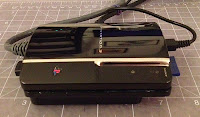 So far, I'm not having a cooling problem with mine. It's possible, though, that you can cut the slots so perfectly to size that air won't flow through them. I don't think the Pi runs hot enough that it needs airflow -- the tin can probably conduct the heat out of there -- but you never know. (Extra credit: add a thermistor to your Pi and have Nagios check it.)
So far, I'm not having a cooling problem with mine. It's possible, though, that you can cut the slots so perfectly to size that air won't flow through them. I don't think the Pi runs hot enough that it needs airflow -- the tin can probably conduct the heat out of there -- but you never know. (Extra credit: add a thermistor to your Pi and have Nagios check it.)I don't know if other tins will fit a Pi. If you do an XBox or Wii, I'd love to hear about it. "Xbox 360.14" doesn't quite have the same ring to it .. but "Wii.14" is kind of fun.
Labels:
make,
raspberry pi,
weekend project
Location:
Hillcrest, San Diego, CA, USA
Thursday, January 10, 2013
Crib Notes for Cocktail Hour
Here are a few conversation starters and lull-breakers I'll be using at cocktail hour.
- The Library of Congress' Flickr Photostream is a great way to at least get something on your walls. I like to think it's Lorem Ipsum for decorating.
- Can Blueseed, a start-up incubator in international waters, streamline visa/legislative/geographical hurdles? So many other possibilities, if you let your mind wander....
- Frog's 20 Tech Trends for 2013 are out. Agree or disagree, they're all thought-provoking. Still conspicuously absent from the list: jet packs.
Labels:
cocktail hour
Location:
Hillcrest, San Diego, CA, USA
Subscribe to:
Posts (Atom)







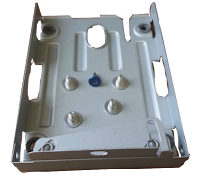
.jpeg)






